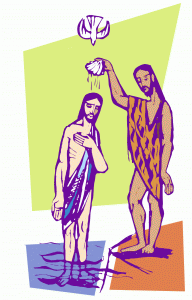Luke 3:15-17, 21-22
This text is used for the Lectionary Year C on January 10, 2016.
 When I was becoming acquainted with the lectionary for the first time, I was under the assumption that Epiphany was a season in the same way that Lent and Advent were. I think I had even heard about the theological purpose of Epiphany: it is the season when Christ is unveiled. Eventually my Episcopal friends would gently correct me, pointing out that it is instead the first instance of ordinary time. Still I don’t think that description, wherever I got it from, is half bad. Think about what comes to us in Epiphany in Year C: a baptism, a party, an epic sermon, Jesus’ dedication and the transfiguration. If Mary had put together a scrapbook, it would probably look like Epiphany.
When I was becoming acquainted with the lectionary for the first time, I was under the assumption that Epiphany was a season in the same way that Lent and Advent were. I think I had even heard about the theological purpose of Epiphany: it is the season when Christ is unveiled. Eventually my Episcopal friends would gently correct me, pointing out that it is instead the first instance of ordinary time. Still I don’t think that description, wherever I got it from, is half bad. Think about what comes to us in Epiphany in Year C: a baptism, a party, an epic sermon, Jesus’ dedication and the transfiguration. If Mary had put together a scrapbook, it would probably look like Epiphany.
‘Ordinary’ seems like an inept description. This timeline is filled with one extraordinary event after another. With this in mind, it might surprise you that I find the bookends of the season extremely difficult to preach. Every year the sun rises and falls on the season after Epiphany with Jesus’ baptism and his transfiguration. After about three years, I found I didn’t have anything left to say. So what do preachers do with Jesus’ baptism?
I think the best place to start is by asking a question that inevitably ends up in my email inbox after every baptism sermon. Why did Jesus have to get baptized? I don’t think it’s unreasonable to assume that the synoptics were asking themselves the same question. If the proposed chronology of authorship of the gospels is correct, then what is visible is that this became a question of increasing importance. Mark thinks it is enough to report that the heavens opened. Luke adds Jesus’ prayer and of course Jesus & John’s familial relationship which has been present since chapter one. Matthew puts all us at ease when he gives us John’s self deprecating insight, namely his suggestion that the situation should be reversed. Matthew also offers the most theologically robust answer, “to fulfill all righteousness.”
Luke and his sequel Acts offer the most theological geography in of the gospels. If we could read Luke/Acts with Jesus flashing like a blue dot on Google Maps, what we’d see is that in Luke Jesus make a slow journey south from Galilee to Jerusalem and there radically redefines the gospel. In Acts, that good news goes to the ends of the earth. Luke gives us the journey of discipleship and in that regard one might argue that Jesus represents the pattern of discipleship. It is a slow march toward the cross to find new life.
Here I find the early church helpful and in particular Irenaeus, who when articulating recapitulation, said that Jesus had to enter “Adam,” the man who truly hungers and thirsts, eats and drinks, is wearied and needs rest, who knows anxiety, sorrow and joy, and who suffers pain when confronted with the fact of death. Perhaps a solution to the original question might be this, Jesus in being baptized is modeling a first step in being truly human.
The Lukan text is thick with suggestive imagery. Because this is the inauguration of the public ministry, this moment provides the gospel authors with an opportunity to allude to the typological nature of Jesus’ status. Luke is no exception. The first place to begin is with the pronouncement, which is three fold. Jesus is son, beloved, and one in whom God is well pleased. I find the latter two more cryptic. Some argue that “well pleased” is a reference to Isaiah 42:1 thus establishing Jesus as a servant figure. “Beloved” is sometimes connected with Genesis 22:16 bolstering the uniqueness of Jesus as God’s only son. I think the best connection is made linking this critical moment in Jesus ministry and the pronouncement son to the Royal imagery found in Psalm 2. Not only does this accomplish what we might hope for in Genesis 22, but it also connects Jesus to the Davidic tradition.
Typological connections are not limited to Jesus’ confession. I think more powerful imagery is in the act of baptism itself. Up to this point Israel has had a long and important relationship with water. In Genesis 1, God’s spirit brooded over the chaotic waters and God called the firmament up out of the waters. When Israel was delivered from the bondage of slavery they were taken through the waters of the Red Sea. And again when Israel was on the brink of claiming their inheritance from God, they passed through the waters of the Jordan. The waters consistently symbolize change in the life of God’s story told through Israel. The blessings of creation, deliverance and promise all come through the waters. In baptism, Jesus redefines the waters. He is God’s mechanism of recreation, complete deliverance and the fulfillment of God’s promise.
One final observation. Karl Barth’s favorite piece of art was the crucifixion piece at the center of the Isenheim Alterpiece. In particular he liked the portrayal of John the Baptist standing to the right of Jesus pointing back at Jesus. Barth said that the point of the Christian life is that finger. In everything we must point to Christ. John the Baptist is a whimsical figure. He, the feeding of the 5,000, and the Passion Week narrative are essentially the only story pieces to feature in all four gospels. And yet he isn’t a disciple and his career ends abruptly. So why does he have such a prominent place? Perhaps because his task, preparing for and pointing toward Jesus, is what we are all called to do. John presents preachers with an opportunity to locate the congregation in the story.
 Joshua Carney
Joshua Carney
Lead Pastor
University Baptist Church, Waco, TX
josh@ubcwaco.org
Tags: baptism, john the Baptist, water, Barth, typology
